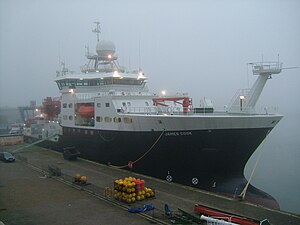RRS James Cook
 RRS James Cook in dock at the National Oceanography Centre, Southampton
| |
| History | |
|---|---|
| Name | RRS James Cook |
| Namesake | James Cook |
| Owner | NERC Research Ship Unit |
| Builder | Flekkefjord Slipp & Maskinfabrikk AS, Norway. Hull built in Gdansk, Poland |
| Cost | £36 million |
| Laid down | 22 March 2005 |
| Launched | 4 November 2005 |
| Christened | February 2007 by Princess Royal |
| Maiden voyage | 5 March 2007 |
| Identification |
|
| Status | in service |
| Notes | [1][2][3] |
| General characteristics | |
| Class and type | Lloyds +100A1, Ice 1C, FS, +LMC, UMS DP(AM) Research Vessel |
| Tonnage | 5,401 GT |
| Length | 89.5 m (294 ft) |
| Beam | 18.6 m (61 ft) |
| Draught | 5.5 m (18 ft) – 5.7 m (19 ft) |
| Installed power |
|
| Propulsion |
|
| Speed | 16 kn (30 km/h; 18 mph) |
| Crew | 9 Officers; 13 Crew & Technicians; 32 Scientists |
| Notes |
|
The RRS James Cook is a British Royal Research Ship operated by the Natural Environment Research Council (NERC). She was built in 2006 to replace the ageing RRS Charles Darwin with funds from Britain's NERC and the DTI's Large Scientific Facilities Fund. She was named after Captain James Cook, the British explorer, navigator and cartographer at the National Oceanography Centre, Southampton by The Princess Royal.[5]
On her maiden scientific voyage, on 5 March 2007, the James Cook set off to study the Fifteen-Twenty Fracture Zone.[6][7]
James Cook was involved in the discovery of what is believed to be the world's deepest undersea volcanic vents, while in the Caribbean in 2010.[8]
In September 2015, while on a cruise studying the seabed and marine life of the Whittard Canyon on the northern margin of the Bay of Biscay, oceanographers pictured what they believe was the first blue whale in English waters since the mammals were almost hunted to extinction in the north-east Atlantic.[9]
In January 2020 she left Fort Lauderdale to take part in the Go-Ship programme of scientific expeditions, studying the changes in the physical and chemical make-up of the North Atlantic as a result of anthropogenic warming. The voyage ended at Tenerife in early March.[10]

See also[]
- RV Neil Armstrong - United States equivalent
References[]
- ^ "Planet Earth" (PDF). NERC. Spring 2007. Archived from the original (PDF) on 19 December 2008. Retrieved 4 January 2008.
- ^ "RRS James Cook". NERC. Archived from the original on 3 July 2012. Retrieved 4 January 2008.
- ^ "RRS James Cook". National Oceanography Centre. Archived from the original on 10 June 2008. Retrieved 4 January 2008.
- ^ "RRS James Cook Ship Specification". rrsjamescook.com. Retrieved 9 October 2010.[permanent dead link]
- ^ "RRS James Cook named by HRH The Princess Royal". Natural Environment Research Council. Archived from the original on 13 March 2010. Retrieved 12 April 2010.
- ^ "RRS James Cook, Research Vessel - Ship Technology". www.ship-technology.com. Retrieved 12 August 2021.
- ^ "Cruise inventory - RRS James Cook JC007 - cruise summary report". British Oceanographic Data Centre. Retrieved 12 August 2021.
- ^ "British scientific expedition discovers world's deepest known undersea volcanic vents". physorg.com. Retrieved 12 April 2010.
- ^ Morris, Steven. "Blue whale caught on camera in English waters 'for the first time'". The Guardian. Retrieved 7 September 2015.
- ^ "NOC RESEARCH EXPEDITION TO ASSESS CONTINUED ABILITY OF NORTH ATLANTIC TO MITIGATE GLOBAL HEATING". Baird Maritime. Retrieved 21 March 2020.
External links[]
| Wikimedia Commons has media related to IMO 9338242. |
- Skipsteknisk AS Design ST-345
- National Oceanography Centre - Sea Systems - RRS James Cook, Southampton
- Movie of the hull launch of the RRS James Cook in Gdansk, Poland
- Natural Environment Research Council
- Oceanographic instrumentation
- Research vessels of the United Kingdom
- 2005 ships
- Ships built in Gdańsk
- Individual ship or boat stubs